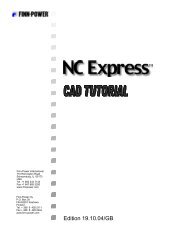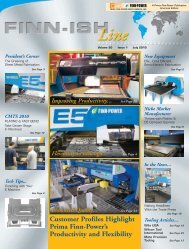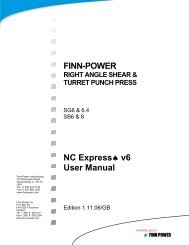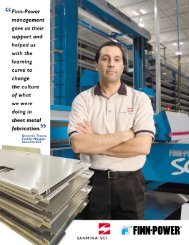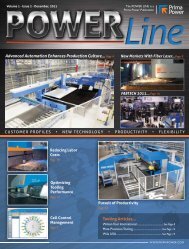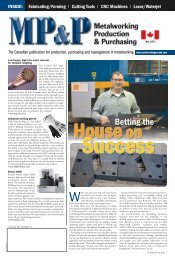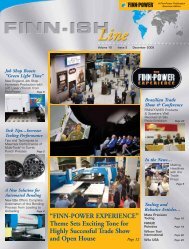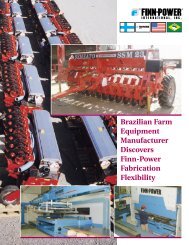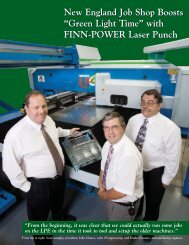Stand-Alone Punch machine user manual - Finn-Power International ...
Stand-Alone Punch machine user manual - Finn-Power International ...
Stand-Alone Punch machine user manual - Finn-Power International ...
You also want an ePaper? Increase the reach of your titles
YUMPU automatically turns print PDFs into web optimized ePapers that Google loves.
Once the <strong>Punch</strong>ing was changed to Stability Area the single punches will be<br />
applied in each separate zone.<br />
Nibbling<br />
Modifying the option, Nibbling Style, will give great functionality to control<br />
the optimization of a sheet. There are two options to set nibbling- Part or<br />
Angle. Depending on how the nibble path (contour) is sorted will effect<br />
how the Nibbling option will change the outcome. Contours that have<br />
nibbling, internally or externally, and have microjoints (sorting that doesn’t<br />
require removal) applied will allow for the Nibbling function to modify the<br />
outcome.<br />
When Part (Nibbling) is selected the nibble paths will be applied to be<br />
processed for each part separately. This means that it may take more time to<br />
process the sheet at the <strong>machine</strong>, because the angle of the tool will need to<br />
be rotated for each different segment.<br />
When Angle (Nibbling) is selected the nibble paths are processed<br />
throughout the sheet (or zone) at the same angle throughout all parts. This<br />
will allow for a quicker run time at the <strong>machine</strong> in most cases. Selecting<br />
Angle will also activate the ability to modify the ‘Motion Principle’ within<br />
the ‘Plate Tools View’. Motion Principle will allow the <strong>user</strong> to control the<br />
distance (range) between the next hit to be selected, which can allow for<br />
more time saved when running the sheet at the <strong>machine</strong>.<br />
6.2 EXERCISE- Automatic Optimization<br />
Within the <strong>Stand</strong>alone environment parts are nested, either automatically or<br />
interactively, and are then ready to be optimized. Automatic Optimization will<br />
process the nested sheets to allow for NC code generation. Assuming tooling, turret<br />
and <strong>machine</strong> parameters are setup correctly the automatic <strong>Punch</strong> Optimizer will<br />
create a result to be run within the <strong>machine</strong>’s capacity.<br />
When a nest is created it may create more than one sheet layout to be processed.<br />
Each sheet can be processed through the <strong>Punch</strong> Optimizer differently or alike. The<br />
<strong>Punch</strong> Optimizer will allow the <strong>user</strong> to optimize as many times needed to achieve the<br />
final result, <strong>machine</strong> ready code. The following exercise will simply walk a <strong>user</strong><br />
through the process to optimize a nest of parts by modifying options within the <strong>Punch</strong><br />
6-103




